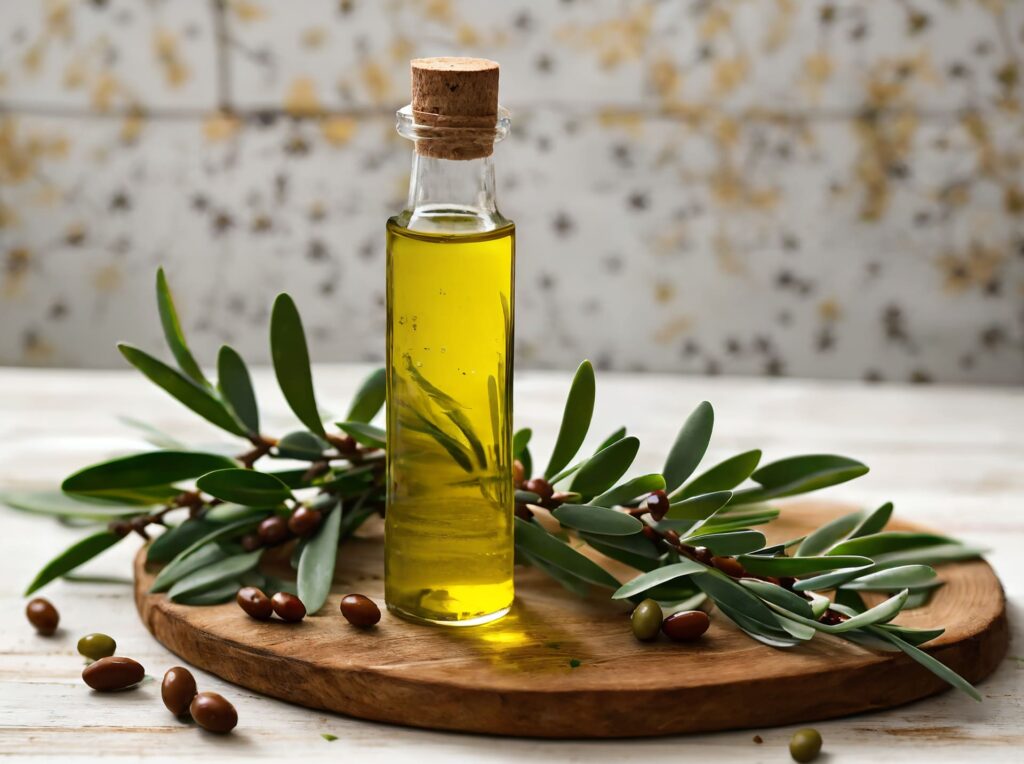Oleic acid is an essential component in many natural oils and fats, known for its multiple health benefits and its importance in the food and cosmetic industry. Below we will tell you what oleic acid is, its chemical formula, properties, health benefits and the foods where it is found. Read on!
What is oleic acid?
Olive acid is a monounsaturated fatty acid that belongs to the omega-9 fatty acid family. It is one of the main components of vegetable oils, especially olive oil, and is found naturally in many foods. Its name derives from the Latin oleum, meaning oil, due to its predominance in fatty products.
This fatty acid is known for its chemical stability, which makes it ideal for use in cooking, and for its health benefits, including anti-inflammatory and cardioprotective properties. It is especially relevant in the Mediterranean diet, considered one of the healthiest in the world.
Oleic acid formula
Chemically, oleic acid has the formula C18H3402. This means that it is composed of 18 carbon atoms, 34 hydrogen atoms and 2 oxygen atoms. It is a fatty acid with a long carbon chain and a single cis-position double bond, which gives it the characteristic of being monounsaturated.
The double bond in its structure differentiates it from saturated fatty acids, which do not contain double bonds, and from polyunsaturated fatty acids, which have more than one. This configuration contributes to its flexibility and its beneficial effect on blood cholesterol levels.
Main properties of oleic acid
Oleic acid stands out for several properties that make it an essential component in food and other sectors such as cosmetics. Some of its most notable properties are:
- Thermal stability: resists high temperatures without degrading easily, making it ideal for cooking.
- Smooth texture: it is a key ingredient in cosmetic products for its ability to moisturize and soften the skin.
- Antioxidant properties: helps fight free radicals, which contributes to the prevention of cellular aging.
- Ease of absorption: the human body metabolizes it efficiently, making the most of its benefits.
- Chemical compatibility: its structure makes it an excellent carrier of nutrients in food and cosmetic formulations.

Health benefits of oleic acid
Oleic acid is widely recognized for its multiple health benefits, supported by numerous scientific studies. Among them, the most prominent are:
- Improves cardiovascular health: helps reduce LDL cholesterol levels and increase HDL, which reduces the risk of heart disease.
- Anti-inflammatory properties: its regular consumption can help reduce inflammation in the body, which is beneficial for people with chronic diseases such as arthritis.
- Weight control: being a healthy fat, it contributes to a greater feeling of satiety, helping to control appetite.
- Supports the immune system: thanks to its antioxidant properties, it protects the body’s cells against oxidative damage.
- Improved brain function: it has been associated with better cognitive health and a lower incidence of neurodegenerative diseases such as Alzheimer’s disease.
What foods can we find it in?
Oleic acid is present in a wide variety of natural foods, mainly in vegetable oils and fats. One of the foods richest in this fatty acid is olive oil. It is the richest source of oleic acid, especially in extra virgin olive oil, where it can represent up to 80% of its composition. Another food where we find a significant portion of this acid is avocado, known for its high content of healthy fats.
We can also find this acid in nuts such as almonds, walnuts and hazelnuts. It is also found in meats and dairy products, although in smaller proportions.
Amount of oleic acid in olive oil
Olive oil is the ultimate source of oleic acid. Depending on the variety and the extraction method, the content of this fatty acid in olive oil can range from 70% to 80% of its total fatty acid composition. In the case of extra virgin olive oil, the oleic acid content is usually higher due to the superior quality of the extraction process.
This high content not only gives olive oil its characteristic mild flavor and texture, but also enhances its health properties. It is a key ingredient in the Mediterranean diet, where it is used both raw and in the preparation of hot dishes.
In short, oleic acid not only contributes to the cardiovascular benefits of olive oil, but also improves its thermal stability, making it ideal for frying and cooking. To discover even more about the properties and benefits of olive oil, and how this oleic acid is extracted, we invite you to visit our olive oil museum. Opting for foods rich in this type of fatty acid not only improves our health, but also connects us to culinary traditions that prioritize wellness and taste.


